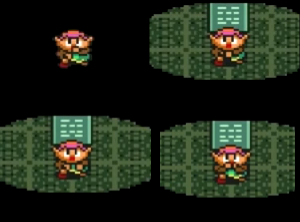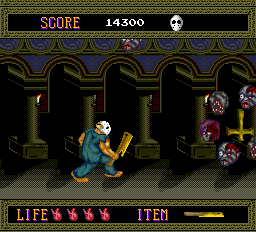Video-game censorship is a touchy subject, but sometimes game companies commit to such silly decisions in relation to it that it become difficult to even justify why such decisions have been made. In this post, I’m going to take a look at some silly instances of game censorship as well as looking at the many ways game companies have tried in the past to prevent offending people’s religious views with games. The latter topic also falls under the definition of censorship foolishness, since the opinions of most religious people towards video-games tend to shift between coldly uninterested to condemning them as the invention of the devil.
Silly Censorship: Why even do that?
I’ve discussed before in this blog that violence and the fear of violent influences tends to motivate most of the extreme and ridiculous cases of video-game censorship. Nothing quite illustrates the ridiculous and ass-backwards logic behind censoring video-game violence like looking at games with horror influences. Firstly, I think anyone would agree that during the NES period it was quite dubious of the LJN company (a toy-company first, video-game company second) to make so many games based on popular horror movies like Jaws, Friday the 13th and A Nightmare on Elm Street (here we’ll ignore the fact that these games were all exceptionally crappy). It should stand to reason that when you base something on a horror film or franchise, then a certain level of blood for instance should be allowed to stay in the game. But surprisingly these games stayed relatively censorship free.
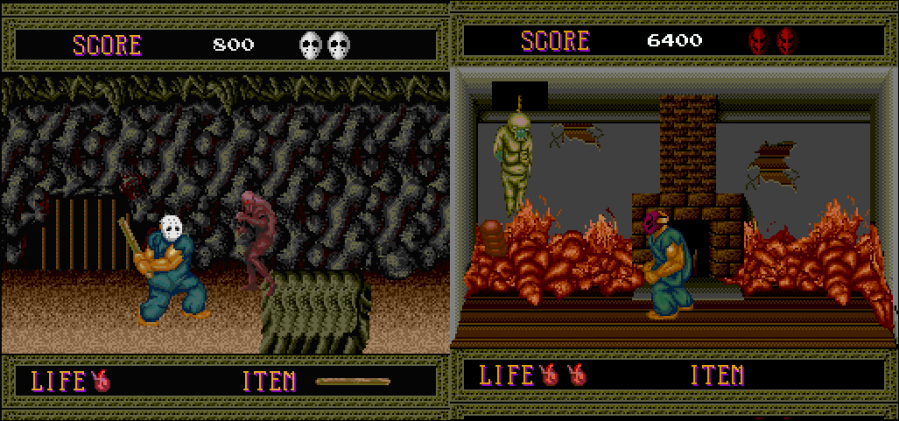 Our first example actually comes from a far less well-known example. The late 1980s beat-em-up title, Splatterhouse, took its inspiration from a number of horror movies, not least of which Friday the 13th (with the main character borrowing Jason Voorhees’ iconic hockey mask). The TurboGrafx-16 port of the title toned down the violence to make the game less disturbing (surprisingly ineffectively in my view) and also, for whatever reason, also changed the colour of the mask worn by the main character. There seems to be no reason for this other than the character looking too much like Jason from Friday, which really makes this one out to be a really silly and unnecessary (not to mention confusing) censorship decision.
Our first example actually comes from a far less well-known example. The late 1980s beat-em-up title, Splatterhouse, took its inspiration from a number of horror movies, not least of which Friday the 13th (with the main character borrowing Jason Voorhees’ iconic hockey mask). The TurboGrafx-16 port of the title toned down the violence to make the game less disturbing (surprisingly ineffectively in my view) and also, for whatever reason, also changed the colour of the mask worn by the main character. There seems to be no reason for this other than the character looking too much like Jason from Friday, which really makes this one out to be a really silly and unnecessary (not to mention confusing) censorship decision.
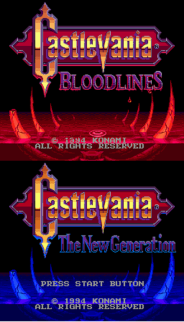 One game series that had struggled long with censorship was Konami’s Castlevania series. There’s countless examples I could pick from the franchise, but I’ll instead focus on two games. Firstly, Castlevania: Bloodlines which received unnecessarily harsh censorship even before the game reached the North American game stores. Characters were redesigned and blood was recoloured and even one of the main characters’ death animations had to be changed because it was deemed too gruesome (the character becoming impaled on his own spear). However, even with all of these alterations the game was due for one more when it was released in Europe where the censors had the title changed to Castlevania: The New Generation. In addition, the opening screen’s ribs swimming in blood were switched to ribs in blue water. Never have I witnessed a more unnecessary graphic change for no other reason than to remove references to “blood” from the title of the game. Similar fate befell Dracula X which in Europe was bizarrely retitled Kiss of the Vampire (I’m not sure what lurid meanings the European censors thought X would entail).
One game series that had struggled long with censorship was Konami’s Castlevania series. There’s countless examples I could pick from the franchise, but I’ll instead focus on two games. Firstly, Castlevania: Bloodlines which received unnecessarily harsh censorship even before the game reached the North American game stores. Characters were redesigned and blood was recoloured and even one of the main characters’ death animations had to be changed because it was deemed too gruesome (the character becoming impaled on his own spear). However, even with all of these alterations the game was due for one more when it was released in Europe where the censors had the title changed to Castlevania: The New Generation. In addition, the opening screen’s ribs swimming in blood were switched to ribs in blue water. Never have I witnessed a more unnecessary graphic change for no other reason than to remove references to “blood” from the title of the game. Similar fate befell Dracula X which in Europe was bizarrely retitled Kiss of the Vampire (I’m not sure what lurid meanings the European censors thought X would entail).
Not only that Super Castlevania 4 also had things changed from it for a wholly stupid reason. Most gamers would never stop to think of this one, but the female statues in the backgrounds of some of the levels have to be redrawn to have them wearing a toga because Nintendo didn’t like the idea of nude statues in a video-game. This seems super ridiculous since most people would probably not even pay attention to the background of a Castlevania game to begin with.
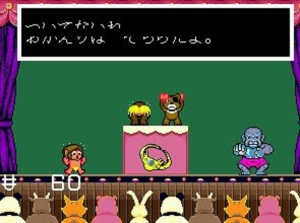 And lest you think Nintendo is the only major game company who was wary of game nudity, Sega also had to alter Alex Kidd in the Enchanted Castle to remove a fairly harmless example of nudity. In the game’s rock-paper-scissor mini games, Alex loses all his clothing in the Japanese version of the game if he loses a match. In the American and European versions of the same game, Alex only gets squashed by an anvil and scutters away after losing the match.
And lest you think Nintendo is the only major game company who was wary of game nudity, Sega also had to alter Alex Kidd in the Enchanted Castle to remove a fairly harmless example of nudity. In the game’s rock-paper-scissor mini games, Alex loses all his clothing in the Japanese version of the game if he loses a match. In the American and European versions of the same game, Alex only gets squashed by an anvil and scutters away after losing the match.
Religion & Games: The Elephant in the Room
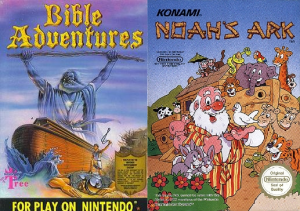
Nintendo always saw itself as being principally family friendly game developer, at least during the years of the NES. To that end, Nintendo consciously avoided releasing any games with religious themes in them. The great irony of course was that one company actually resorted to illegal means to distribute Christian-themed games for the NES. Wisdom Tree was one of a number of companies who released unlicensed games for the NES and their products have gathered a fair bit of notoriety because of that. Nintendo were also inconsistent in their policies and let a 1992 platformer called Noah’s Ark slip through the system. It’s really baffling why Nintendo, who vehemently avoided upsetting religious (and non-religious) sensibilities allowed a fully licensed biblical game get released for the system yet drove another company to resort to lock-out circumvention.
Well, maybe I’m being a little hard on Nintendo since there were probably other factors involved. For one, Wisdom Tree already had a past as a unlicenced game developer from even before their reformation into a religious games company. Also, Konami’s Noah’s Ark game was only released in Europe and at a time when the NES was being phased out in favour of the SNES, which might help explain why Nintendo decided to show some leniency in the matter.
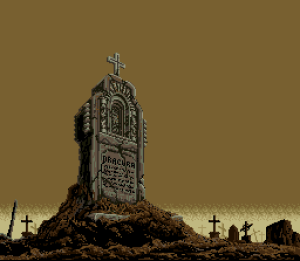 What perhaps shows Nintendo’s strict rules regarding religion in games weakening was a clear example of Link doing the sign of the cross in A Link to the Past. However, Konami was still getting some heat for Super Castlevania IV‘s intro where lightning strikes Dracula’s tomb-stone during the opening releasing the Prince of Darkness. This intro was edited for its western release to remove the cross which was located atop the tomb-stone, again, to avoid insulting religious sensibilities.
What perhaps shows Nintendo’s strict rules regarding religion in games weakening was a clear example of Link doing the sign of the cross in A Link to the Past. However, Konami was still getting some heat for Super Castlevania IV‘s intro where lightning strikes Dracula’s tomb-stone during the opening releasing the Prince of Darkness. This intro was edited for its western release to remove the cross which was located atop the tomb-stone, again, to avoid insulting religious sensibilities.
We can definitely say that in issues of religion and religious symbols in games, major distributors tend to tread carefully. Returning for this final example to Splatterhouse, NEC’s cleaning up of the game for its western release wasn’t simply a matter of de-gorifying the game, but also removing other slightly questionable material, such as a boss which was an upside-down cross (commonly associated with Satan worship) surrounded by zombified heads. The whole idea, I’ll grant, is a little extreme – but it demonstrates, once again, that Nintendo wasn’t alone in treating certain censorship principles rather severely.
